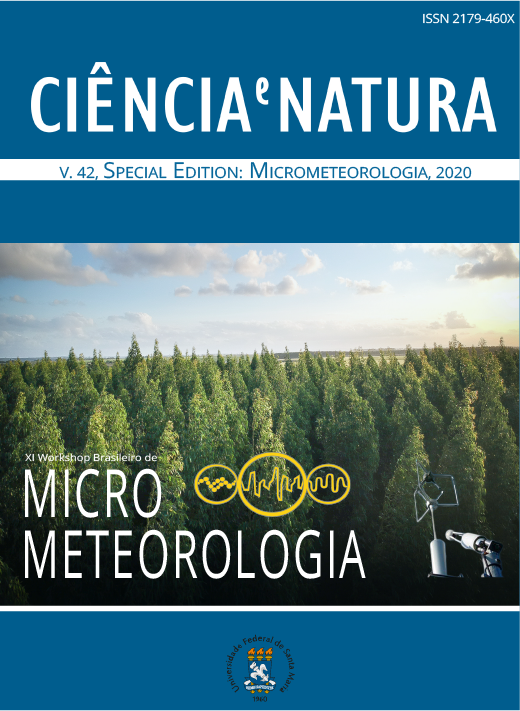Planetary boundary layer height estimated at the Alcântara Launch Center
DOI:
https://doi.org/10.5902/2179460X46924Keywords:
PBL height, Remote sensing, Coastal boundary layerAbstract
Sea and land breeze circulation and the internal boundary layer are some aspects that make it difficult to determine the coastal Planetary Boundary Layer (PBL) height (h). This paper evaluates the h estimation for the Alcantara Launch Center (CLA) in Maranhão state using 14 months of remote measurements obtained by a ceilometer and by the ERA5 reanalysis. This response depends on the concentration of aerosols and atmospheric humidity present. Mean results indicated that dry months (September to November, with = 637 488 m) tend to have less hourly and seasonal variability of h compared to wet months (March to May, with = 770 912 m). A higher mean error in the wet season was obtained with ERA5 PBL h (h = 708 53 m over the land; e h = 648 46 m over the ocean) than in the dry season (h = 18 89 m; e h = 46 77 m). The greater amount of atmospheric humidity during the rainy season increases the estimation uncertainty. This condition was more frequent at night due to typical rainfall in the place.
Downloads
References
AVOLIO, E. et al. Sensitivity analysis of WRF model PBL schemes in simulating boundary-layer variables in southern Italy: An experimental campaign. Atmospheric Research, Elsevier, v. 192, p. 58–71, 2017.
CARNEIRO, R. G. et al. Determinação da altura da camada limite planetária na floresta amazônica utilizando um ceilômetro. Ciência e Natura, v. 38, n. Ed. Especial, p. 460–466, 2016.
Copernicus Climate Change Service - C3S. ERA5: Fifth generation of ECMWF atmospheric reanalyses of the global climate. 2017. Disponível em: https://cds.climate.copernicus.eu/cdsapp{#}!/h.
FISCH, G. Características do perfil vertical do vento no Centro de Lançamento de Foguetes de Alcântara (CLA). Revista Brasileira de Meteorologia, v. 14, n. 1, p. 11–21, 1999.
FISCH, G. The heights of the Atmospheric Boundary Layer at a coastal region using remote sensing and in situ measurements. In: 16th International Symposium for the Advancement of Boundary-Layer Remote Sensing. Boulder, Colorado (EUA): ISARS, 2012.
PIRES, L. B. M. Estudo da Camada Limite Interna desenvolvida em falésias com aplicação para o Centro de Lançamento de Alcântara. 2009. 167 p. Tese (Doutorado em Meteorologia) - Instituto Nacional de Pesquisas Espaciais - INPE, 2009.
RAMOS, D. N. d. S.; FERNANDEZ, J. P. R.; FISCH, G. Evolution of the Planetary Boundary Layer on the northern coast of Brazil during the CHUVA campaign. Atmospheric Research, v. 203C, p. 298–310, 2018.
SCHWEEN, J. H. et al. Mixing-layer height retrieval with ceilômetro and Doppler lidar: From case studies to long-term assessment. Atmospheric Measurement Techniques, v. 7, n. 11, p. 3685–3704, 2014.
SEIDEL, D. J. et al. Climatology of the planetary boundary layer over the continental United States and Europe. J. Geophys. Res. Atmos., v. 117, n. D17. 2012.
STULL, R. Practical Meteorology: An Algebra-based Survey of Atmospheric Science. 1st ed. Vancouver, BC, Canada: Sundog Publishing, p. 942, 2015.
Downloads
Published
How to Cite
Issue
Section
License
To access the DECLARATION AND TRANSFER OF COPYRIGHT AUTHOR’S DECLARATION AND COPYRIGHT LICENSE click here.
Ethical Guidelines for Journal Publication
The Ciência e Natura journal is committed to ensuring ethics in publication and quality of articles.
Conformance to standards of ethical behavior is therefore expected of all parties involved: Authors, Editors, Reviewers, and the Publisher.
In particular,
Authors: Authors should present an objective discussion of the significance of research work as well as sufficient detail and references to permit others to replicate the experiments. Fraudulent or knowingly inaccurate statements constitute unethical behavior and are unacceptable. Review Articles should also be objective, comprehensive, and accurate accounts of the state of the art. The Authors should ensure that their work is entirely original works, and if the work and/or words of others have been used, this has been appropriately acknowledged. Plagiarism in all its forms constitutes unethical publishing behavior and is unacceptable. Submitting the same manuscript to more than one journal concurrently constitutes unethical publishing behavior and is unacceptable. Authors should not submit articles describing essentially the same research to more than one journal. The corresponding Author should ensure that there is a full consensus of all Co-authors in approving the final version of the paper and its submission for publication.
Editors: Editors should evaluate manuscripts exclusively on the basis of their academic merit. An Editor must not use unpublished information in the editor's own research without the express written consent of the Author. Editors should take reasonable responsive measures when ethical complaints have been presented concerning a submitted manuscript or published paper.
Reviewers: Any manuscripts received for review must be treated as confidential documents. Privileged information or ideas obtained through peer review must be kept confidential and not used for personal advantage. Reviewers should be conducted objectively, and observations should be formulated clearly with supporting arguments, so that Authors can use them for improving the paper. Any selected Reviewer who feels unqualified to review the research reported in a manuscript or knows that its prompt review will be impossible should notify the Editor and excuse himself from the review process. Reviewers should not consider manuscripts in which they have conflicts of interest resulting from competitive, collaborative, or other relationships or connections with any of the authors, companies, or institutions connected to the papers.






